Aaron Steven White
Generating event descriptions under syntactic and semantic constraints
Dec 24, 2024
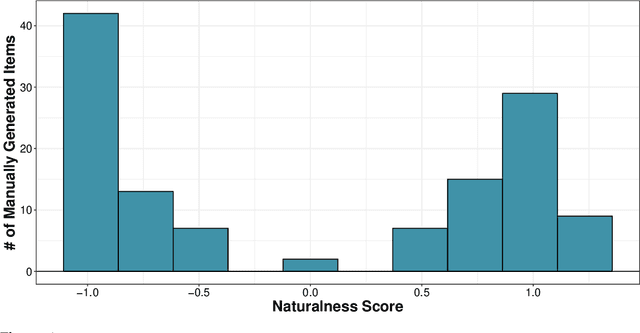

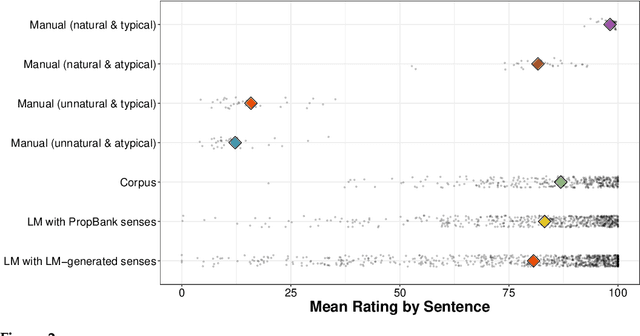
Abstract:With the goal of supporting scalable lexical semantic annotation, analysis, and theorizing, we conduct a comprehensive evaluation of different methods for generating event descriptions under both syntactic constraints -- e.g. desired clause structure -- and semantic constraints -- e.g. desired verb sense. We compare three different methods -- (i) manual generation by experts; (ii) sampling from a corpus annotated for syntactic and semantic information; and (iii) sampling from a language model (LM) conditioned on syntactic and semantic information -- along three dimensions of the generated event descriptions: (a) naturalness, (b) typicality, and (c) distinctiveness. We find that all methods reliably produce natural, typical, and distinctive event descriptions, but that manual generation continues to produce event descriptions that are more natural, typical, and distinctive than the automated generation methods. We conclude that the automated methods we consider produce event descriptions of sufficient quality for use in downstream annotation and analysis insofar as the methods used for this annotation and analysis are robust to a small amount of degradation in the resulting event descriptions.
Cross-Document Event-Keyed Summarization
Oct 18, 2024



Abstract:Event-keyed summarization (EKS) requires generating a summary about a specific event described in a document, given the document and an event representation extracted from it. In this work, we extend EKS to the cross-document setting (CDEKS), in which summaries must synthesize information from accounts of the same event given by multiple sources. We introduce SEAMUS (Summaries of Events Across Multiple Sources), a high-quality dataset for CDEKS based on an expert reannotation of the FAMUS dataset for cross-document argument extraction. We present a suite of baselines on SEAMUS, covering both smaller, fine-tuned models, as well as zero- and few-shot prompted LLMs, along with detailed ablations, and a human evaluation study, showing SEAMUS to be a valuable benchmark for this new task.
Small Models Are (Still) Effective Cross-Domain Argument Extractors
Apr 12, 2024



Abstract:Effective ontology transfer has been a major goal of recent work on event argument extraction (EAE). Two methods in particular -- question answering (QA) and template infilling (TI) -- have emerged as promising approaches to this problem. However, detailed explorations of these techniques' ability to actually enable this transfer are lacking. In this work, we provide such a study, exploring zero-shot transfer using both techniques on six major EAE datasets at both the sentence and document levels. Further, we challenge the growing reliance on LLMs for zero-shot extraction, showing that vastly smaller models trained on an appropriate source ontology can yield zero-shot performance superior to that of GPT-3.5 or GPT-4.
Event-Keyed Summarization
Feb 10, 2024



Abstract:We introduce event-keyed summarization (EKS), a novel task that marries traditional summarization and document-level event extraction, with the goal of generating a contextualized summary for a specific event, given a document and an extracted event structure. We introduce a dataset for this task, MUCSUM, consisting of summaries of all events in the classic MUC-4 dataset, along with a set of baselines that comprises both pretrained LM standards in the summarization literature, as well as larger frontier models. We show that ablations that reduce EKS to traditional summarization or structure-to-text yield inferior summaries of target events and that MUCSUM is a robust benchmark for this task. Lastly, we conduct a human evaluation of both reference and model summaries, and provide some detailed analysis of the results.
MultiMUC: Multilingual Template Filling on MUC-4
Jan 29, 2024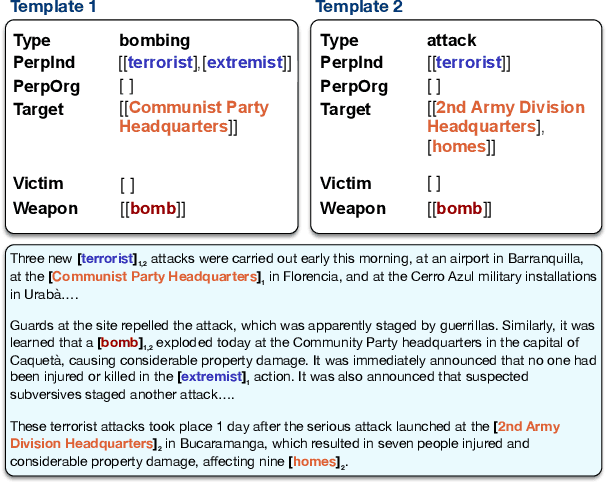
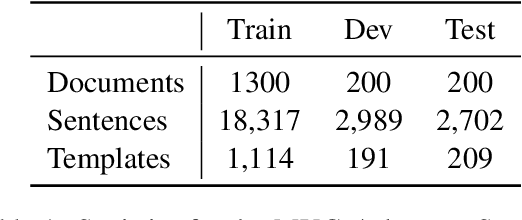
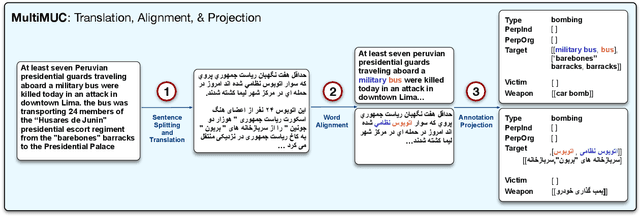

Abstract:We introduce MultiMUC, the first multilingual parallel corpus for template filling, comprising translations of the classic MUC-4 template filling benchmark into five languages: Arabic, Chinese, Farsi, Korean, and Russian. We obtain automatic translations from a strong multilingual machine translation system and manually project the original English annotations into each target language. For all languages, we also provide human translations for sentences in the dev and test splits that contain annotated template arguments. Finally, we present baselines on MultiMUC both with state-of-the-art template filling models and with ChatGPT.
FAMuS: Frames Across Multiple Sources
Nov 09, 2023Abstract:Understanding event descriptions is a central aspect of language processing, but current approaches focus overwhelmingly on single sentences or documents. Aggregating information about an event \emph{across documents} can offer a much richer understanding. To this end, we present FAMuS, a new corpus of Wikipedia passages that \emph{report} on some event, paired with underlying, genre-diverse (non-Wikipedia) \emph{source} articles for the same event. Events and (cross-sentence) arguments in both report and source are annotated against FrameNet, providing broad coverage of different event types. We present results on two key event understanding tasks enabled by FAMuS: \emph{source validation} -- determining whether a document is a valid source for a target report event -- and \emph{cross-document argument extraction} -- full-document argument extraction for a target event from both its report and the correct source article. We release both FAMuS and our models to support further research.
A Unified View of Evaluation Metrics for Structured Prediction
Oct 20, 2023Abstract:We present a conceptual framework that unifies a variety of evaluation metrics for different structured prediction tasks (e.g. event and relation extraction, syntactic and semantic parsing). Our framework requires representing the outputs of these tasks as objects of certain data types, and derives metrics through matching of common substructures, possibly followed by normalization. We demonstrate how commonly used metrics for a number of tasks can be succinctly expressed by this framework, and show that new metrics can be naturally derived in a bottom-up way based on an output structure. We release a library that enables this derivation to create new metrics. Finally, we consider how specific characteristics of tasks motivate metric design decisions, and suggest possible modifications to existing metrics in line with those motivations.
MegaWika: Millions of reports and their sources across 50 diverse languages
Jul 13, 2023Abstract:To foster the development of new models for collaborative AI-assisted report generation, we introduce MegaWika, consisting of 13 million Wikipedia articles in 50 diverse languages, along with their 71 million referenced source materials. We process this dataset for a myriad of applications, going beyond the initial Wikipedia citation extraction and web scraping of content, including translating non-English articles for cross-lingual applications and providing FrameNet parses for automated semantic analysis. MegaWika is the largest resource for sentence-level report generation and the only report generation dataset that is multilingual. We manually analyze the quality of this resource through a semantically stratified sample. Finally, we provide baseline results and trained models for crucial steps in automated report generation: cross-lingual question answering and citation retrieval.
On Event Individuation for Document-Level Information Extraction
Dec 19, 2022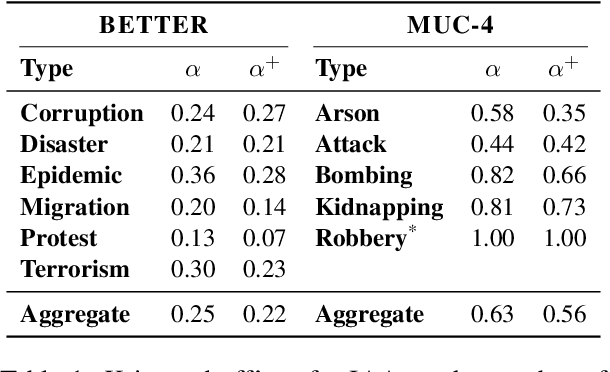
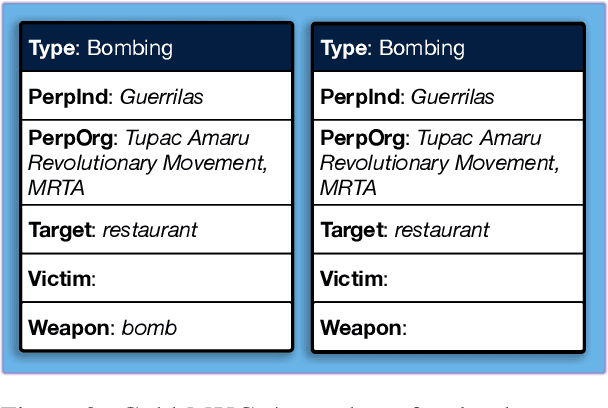
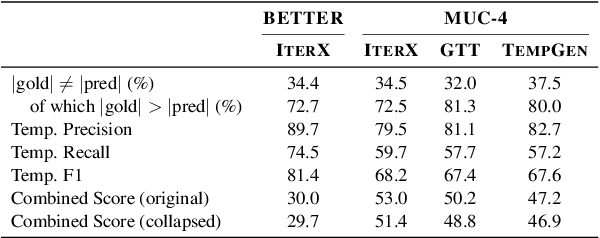
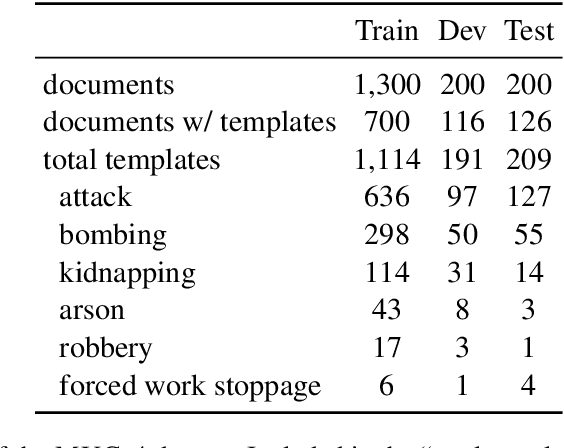
Abstract:As information extraction (IE) systems have grown more capable at whole-document extraction, the classic task of \emph{template filling} has seen renewed interest as a benchmark for evaluating them. In this position paper, we call into question the suitability of template filling for this purpose. We argue that the task demands definitive answers to thorny questions of \emph{event individuation} -- the problem of distinguishing distinct events -- about which even human experts disagree. We show through annotation studies and error analysis that this raises concerns about the usefulness of template filling evaluation metrics, the quality of datasets for the task, and the ability of models to learn it. Finally, we consider possible solutions.
Iterative Document-level Information Extraction via Imitation Learning
Oct 12, 2022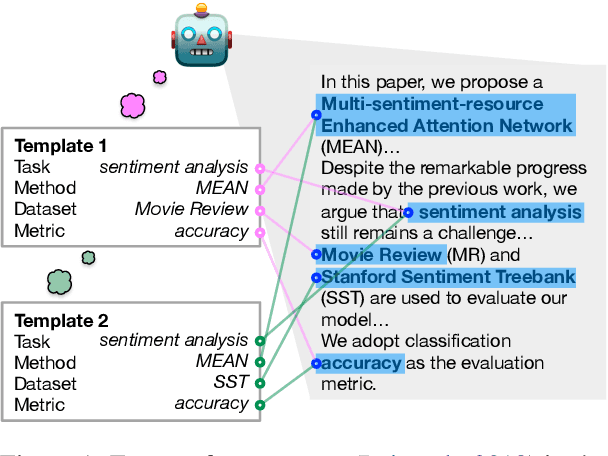
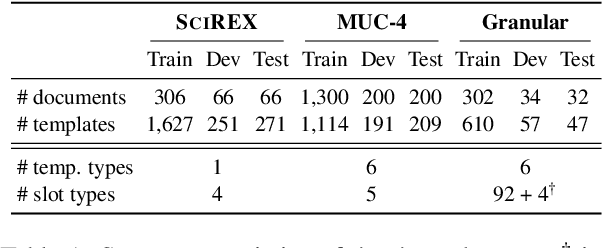


Abstract:We present a novel iterative extraction (IterX) model for extracting complex relations, or templates, i.e., N-tuples representing a mapping from named slots to spans of text contained within a document. Documents may support zero or more instances of a template of any particular type, leading to the tasks of identifying the templates in a document, and extracting each template's slot values. Our imitation learning approach relieves the need to use predefined template orders to train an extractor and leads to state-of-the-art results on two established benchmarks -- 4-ary relation extraction on SciREX and template extraction on MUC-4 -- as well as a strong baseline on the new BETTER Granular task.
 Add to Chrome
Add to Chrome Add to Firefox
Add to Firefox Add to Edge
Add to Edge